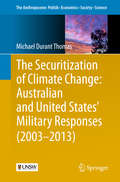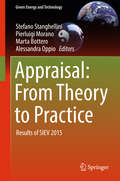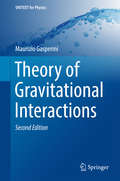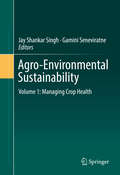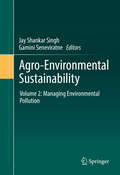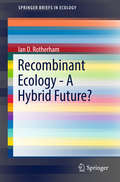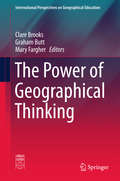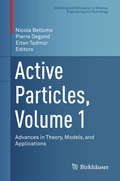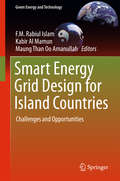- Table View
- List View
The Securitization of Climate Change: Australian and United States' Military Responses (The Anthropocene: Politik—Economics—Society—Science #10)
by Michael Durant ThomasThis book examines how the armed forces of the United States and Australia have responded to the threat posed by climate change to national security. Drawing on established securitisation frameworks (‘Copenhagen’ and ‘Paris’ Schools), the author uses a combination of quantitative and qualitative techniques to systematically examine more than 3,500 speeches, policies and doctrinal articles since 2003. Importantly, the author undertakes an examination of the intersection between the political and the military spheres, probing the question of how ideology has influenced the military’s uptake on the issue. In this context, the author identifies the difficulty of an ostensibly apolitical institution responding to what has become both a hyper-political issue and an unprecedented security threat. A close examination of the key political actors – their intent, outlook and political mandate for broader climate action – is therefore crucial to understanding the policy freedom and constraints within which military leaders operate. The book consists of eight chapters divided into four parts, focusing on: perspectives and methodological insights; empirical case studies; case study comparison; and concluding observations.• Offers a rare and systematic examination of military climate policy by a military officer from Australia• Identifies a divergence of Australian military climate policy from that of the US military during the Obama Administration• Develops a unique method that quantifies climate security, enabling a graphical representation for quick and ready reference ideally suited to policy-makers
Appraisal: Results of SIEV 2015 (Green Energy and Technology)
by Stefano Stanghellini Pierluigi Morano Marta Bottero Alessandra OppioThis book documents the state of the art and the emerging operational perspectives in the field of the appraisal discipline. It covers a wide range of topics, including energy efficiency, environmental sustainability, socio-economic evaluation of regional and urban transformations, real estate and facility management, risk management. It also discusses the potential role of appraisal in minimising unexpected consequences; the role of evaluators in urban development projects as well as the contribution of several methodologies with respect to the overall planning and design processes; the need to manage the complexity of the current decision contexts, while at the same time promoting efficient and effective evaluation processes; improving the quality of discussion and communication of the outcomes of evaluation processes; as well as the appropriateness of current regulation and policy regimes (EU, national, regional etc.). It comprises a selection of the best papers presented at the SIEV 2015 conference "Appraisal: Current Issues and Problems", which was held in Bari, Italy, in July 2015, and brought together architects, engineers, urban planners, decision-makers and government representatives.
Theory of Gravitational Interactions (UNITEXT for Physics)
by Maurizio GasperiniThis is the second edition of a well-received book that is a modern, self-contained introduction to the theory of gravitational interactions. The new edition includes more details on gravitational waves of cosmological origin, the so-called brane world scenario, and gravitational time-delay effects.The first part of the book follows the traditional presentation of general relativity as a geometric theory of the macroscopic gravitational field, while the second, more advanced part discusses the deep analogies (and differences) between a geometric theory of gravity and the gauge theories of the other fundamental interactions. This fills a gap within the traditional approach to general relativity which usually leaves students puzzled about the role of gravity. The required notions of differential geometry are reduced to the minimum, allowing room for aspects of gravitational physics of current phenomenological and theoretical interest, such as the properties of gravitational waves, the gravitational interactions of spinors, and the supersymmetric and higher-dimensional generalization of the Einstein equations. This textbook is primarily intended for students pursuing a theoretical or astroparticle curriculum but is also relevant for PhD students and young researchers.
High Performance Soft Magnetic Materials (Springer Series in Materials Science #252)
by Arcady ZhukovThis book provides comprehensive coverage of the current state-of-the-art in soft magnetic materials and related applications, with particular focus on amorphous and nanocrystalline magnetic wires and ribbons and sensor applications. Expert chapters cover preparation, processing, tuning of magnetic properties, modeling, and applications. Cost-effective soft magnetic materials are required in a range of industrial sectors, such as magnetic sensors and actuators, microelectronics, cell phones, security, automobiles, medicine, health monitoring, aerospace, informatics, and electrical engineering. This book presents both fundamentals and applications to enable academic and industry researchers to pursue further developments of these key materials. This highly interdisciplinary volume represents essential reading for researchers in materials science, magnetism, electrodynamics, and modeling who are interested in working with soft magnets.
Agro-Environmental Sustainability: Volume 1: Managing Crop Health
by Jay Shankar Singh Gamini SeneviratneThis two-volume work is a testament to the increasing interest in the role of microbes in sustainable agriculture and food security. Advances in microbial technologies are explored in chapters dealing with topics such as carbon sequestration, soil fertility management, sustainable crop production, and microbial signaling networks. Volume I is a collection of research findings that invites readers to examine the application of microbes in reinstating degraded ecosystems and also in establishing sustainable croplands. Highly readable entries attempt to close the knowledge gap between soil microbial associations and sustainable agriculture. An increase in the global population with changing climate is leading to environments of various abiotic and biotic stresses for agricultural crops. It therefore becomes important to identify the techniques to improve soil fertility and function using different microbial groups such as actinobacteria, microalgae, fluorescent pseudomonads and cyanobacterial systems. These are examined in this volume in greater detail. This work is a significant contribution to research in this increasingly important discipline, and will appeal to researchers in microbiology, agriculture, environmental sciences, and soil and crop sciences.
Agro-Environmental Sustainability: Volume 2: Managing Environmental Pollution
by Jay Shankar Singh Gamini SeneviratneThis two-volume work is a testament to the increasing interest in the role of microbes in sustainable agriculture and food security. Advances in microbial technologies are explored in chapters dealing with topics such as plant-microbe interactions, rhizoremediation and cyanoremediation, and bio-immobilization. Volume II is a collection of research findings that invites readers to examine the application of microbes in pollution reduction, decontamination of agro- and aquatic ecosystems, and remediation of various toxic compounds. Highly readable entries attempt to close the knowledge gap between soil microbial associations and sustainable agriculture. Traditional agricultural management techniques have relied heavily on application of chemical fertilizers and pesticides; and recent land use change practices have led to over exploitation of natural resources. Strategies outlined here simplify a complicated picture of the way microbial communities can improve the quality of environment and eliminate food scarcity in the coming generations. This work is a significant contribution to research in this increasingly important discipline of soil sciences, and will appeal to researchers in microbiology, agriculture, environmental sciences, and soil and crop sciences.
Creating Low Carbon Cities
by Shobhakar Dhakal Matthias RuthThis book addresses key topics in the current deliberations and debates on low carbon cities that are underway globally. Contributions by experts from around the world focus on the key factors required for creating low carbon cities. These include appropriate infrastructure, ensuring co-benefits of climate actions, making best use of knowledge and information, proper accounting of emissions, and social factors such as behavioral change. Readers will gain a better understanding of these drivers and explore potential transformation pathways for cities.Particular emphasis is given to the current situation of energy consumption and greenhouse gas (GHG) emissions at the urban level, stressing the complexity of measuring GHG emissions from cities. Chapters also shed new light on the long-term transformation pathways towards low carbon. This book discusses key challenges and opportunities in all these domains to aid in creating low carbon cities, making it of value to policy makers, researchers in academia and consultants working on climate change and energy issues.“The low carbon cities agenda is of bold ambition and demands rapid societal transformation. This book provides invaluable information and analysis on how the goals of this agenda can be achieved and what will be the significant obstacles in the way. The content in the book goes below the surface to reveal on-the-ground economic, engineering and equity issues that are at the heart of the Paris Climate Agreement and the ensuing policy debates. In this way, Creating Low Carbon Cities serves as a critical scholarly benchmark and as a toolkit for further action."William Solecki, Professor, Institute for Sustainable Cities, City University of New York"Creating Low Carbon Cities provides a refreshingly critical approach to low-carbon urban development, what has been achieved so far and the challenges ahead. It will be an important data-driven resource for local leaders, sustainability practitioners and urban planners.”Ms. Monika Zimmermann, Deputy Secretary General, ICLEI—Local Governments for Sustainability
Recombinant Ecology - A Hybrid Future? (SpringerBriefs in Ecology)
by Ian D. RotherhamThis is a challenging new approach to understanding ecological systems especially in urban and urbanised areas. Synthesising current ideas and approaches the book develops an historic context to ecological fusion and recombinant or hybrid ecosystems. With massive climate change and other environmental fluxes, this volume provides insight into consequences for future ecologies. Invasive and non-native or alien species are spreading, often aggressively around the globe. However, much current thinking in ecology and nature conservation fails to accommodate the consequences of changing environmental conditions and fusion of both species and ecological communities. Whether or not conservationists accept ecological change, factors such as urbanisation and globalisation combine with climate and other changes to trigger new hybrid communities and ecologies. Embedding this approach into current ecological thinking this book presents an overview of ideas set in the exemplar case study area of the British Isles. However, the approaches, ideas and conclusions presented here will find application in ecosystem studies and in nature conservation around the world.
Regional Upgrading in Southern Europe: Spatial Disparities and Human Capital (Advances in Spatial Science)
by Madalena Fonseca Ugo FratesiThe book is aimed at a wide audience, including academics, economic geography, spatial planning and regional policy researchers, institutional leaders and managers, national and institutional policy makers, practitioners, administrators, master's and senior bachelor's students on related courses, general readers. A list of courses and corresponding programmes in Geography, Planning, Economics and Management will be prepared later.
Quantum Chemical Approach for Organic Ferromagnetic Material Design (SpringerBriefs in Molecular Science)
by Yuriko Aoki Yuuichi Orimoto Akira ImamuraThis brief provides an overview of theoretical research in organic ferromagnetic material design using quantum chemical approaches based on molecular orbital theory from primary Hückel to ab initio levels of theory. Most of the content describes the authors’ approach to identify simple and efficient guidelines for magnetic design, which have not been described in other books. Individual chapters cover quantum chemistry methods that may be used to find hydrocarbon systems with degenerate non-bonding molecular orbitals that interact with each other, to identify high-spin-preferred systems using an analytical index that allows for simple design of high-spin systems as well as to analyze the effect of high-spin stability through orbital interactions. The extension of these methods to large systems is discussed.This book is a valuable resource for students and researchers who are interested in quantum chemistry related to magnetic property.
Atlas of Trace Fossils in Well Core: Appearance, Taxonomy and Interpretation
by Dirk KnaustThis book provides readers with a well-balanced blend of high-quality photographs, figures and accompanying texts on the identification of trace fossils, both in core and in outcrop. Ichnological data has become increasingly important in sedimentological and paleoenvironmental interpretations, not only in the exploration and exploitation of hydrocarbons but also in the characterization of aquifers and in scientific drilling.Following an introduction to the study of trace fossils in core and an outline of ichnological basics, principles and concepts, the book provides detailed descriptions and interpretations of 39 trace fossils (ichnogenera) and associated features (such as bioturbate texture, plant roots and their traces, borings and pseudo-trace fossils) commonly encountered in well cores and in outcrop. The trace fossils are highlighted by their expression in well cores and illustrated with carefully prepared, eye-catching core photographs. This unique information is complemented by examples of trace fossils in outcrop, as well as relevant key figures from the literature.Each description is presented in a consistent manner, stating the ichnogenus name and author in the title, followed by sections on the morphology and size, ichnotaxonomy, substrate, appearance in core, similar trace fossils, producers, ethology, depositional environment, ichnofacies, age, and reservoir quality. An extensive list of references per chapter for further reading rounds out the book, which is based on the author’s continuous work with trace fossils in core over the past two decades.
Coastline Changes of the Baltic Sea from South to East: Past and Future Projection (Coastal Research Library #19)
by Jan Harff Kazimierz Furmańczyk Hans Von StorchThis book discusses sea-level and coastline changes. These topics are becoming increasingly important for populations living along the edge of the world’s oceans and seas, especially in areas where eustatic sea-level rise is superimposed on isostatic subsidence and storm-induced coastal erosion. This is the case at the southern and eastern Baltic Sea coast: in the south, glacio-isostatic subsidence enhances the effect of climate-induced sea-level rise and strong storm effects are causing a continuous retreat of the coast. On the eastern coast glacio-isostatic uplift compensates for eustatic sea-level rise, but storm-induced waves are responsible for permanent morphodynamic changes to the coastline. There is an increasing need for protection concepts for defense but also for the economic use of the different types of coastal zones. The elaboration of these management concepts can be facilitated through models that generate future projections of coastal developments in the light of modern climate change. This anthology comprises the results of the research project “Coastline Changes of the southern Baltic Sea – Past and future projection (CoPaF)” funded by the Polish Ministry of Science and Higher Education, which was run by a team of Estonian, German, Lithuanian, and Polish geoscientists and coastal engineers from 2010 to 2013 and overlapped with and complemented the work of COST Action SPLASHCOS supported by COST (European Cooperation in Science and Technology). As the southern and eastern Baltic serves as a natural laboratory for the investigation of coastal processes, the project’s findings contribute not only to the solution of regional problems in Baltic coastal research and engineering, but also to worldwide interests in description, modelling and parameterization of coastal processes and morphodynamics.
Global Gravity Field Modeling from Satellite-to-Satellite Tracking Data (Lecture Notes in Earth System Sciences)
by Majid Naeimi Jakob FluryThis book provides a sound theoretical basis for the the different gravity field recovery methods and the numerics of satellite-to-satellite tracking data. It represents lectures given at the ‘Wilhelm and Else Heraeus Autumn School’ in Bad Honnef, Germany, October 4-9, 2015. The emphasis of the school was on providing a sound theoretical basis for the different gravity field recovery methods and the numerics of data analysis. The approaches covered here are the variational equations (classical approach), the acceleration approach and the energy balance approach, all of which are used for global gravity field recovery on the basis of satellite observations. The theory of parameter estimation in satellite gravimetry and concepts for orbit determination are also included. The book guides readers through a broad range of topics in satellite gravimetry, supplemented by the necessary theoretical background and numerical examples. While it provides a comprehensive overview for those readers who are already familiar with satellite gravity data processing, it also offers an essential reference guide for graduate and undergraduate students interested in this field.
Understanding Acoustics: An Experimentalist’s View of Acoustics and Vibration (Graduate Texts in Physics)
by Steven L. GarrettThis textbook provides a unified approach to acoustics and vibration suitable for use in advanced undergraduate and first-year graduate courses on vibration and fluids. The book includes thorough treatment of vibration of harmonic oscillators, coupled oscillators, isotropic elasticity, and waves in solids including the use of resonance techniques for determination of elastic moduli. Drawing on 35 years of experience teaching introductory graduate acoustics at the Naval Postgraduate School and Penn State, the author presents a hydrodynamic approach to the acoustics of sound in fluids that provides a uniform methodology for analysis of lumped-element systems and wave propagation that can incorporate attenuation mechanisms and complex media. This view provides a consistent and reliable approach that can be extended with confidence to more complex fluids and future applications. Understanding Acoustics opens with a mathematical introduction that includes graphing and statistical uncertainty, followed by five chapters on vibration and elastic waves that provide important results and highlight modern applications while introducing analytical techniques that are revisited in the study of waves in fluids covered in Part II. A unified approach to waves in fluids (i.e., liquids and gases) is based on a mastery of the hydrodynamic equations. Part III demonstrates extensions of this view to nonlinear acoustics. Engaging and practical, this book is a must-read for graduate students in acoustics and vibration as well as active researchers interested in a novel approach to the material.
The Power of Geographical Thinking (International Perspectives on Geographical Education)
by Clare Brooks Graham Butt Mary FargherIn this book geography educators from around the globe discuss their research into the power of geographical thinking and consider successful strategies to implement, improve and advance geography education in research and practice. It addresses key topics in geography education, such as multicultural competence, the role of teachers, the geography curriculum, spatial thinking, geographic information systems, geocapabilities, and climate change. At a global level the contributors and editors bring together the most advanced collection of research and discussion surrounding issues in geography education. The book will be of interest to geography education researchers worldwide, including academics at university and teachers in schools, as well as professional geographers with an interest in education.
Active Particles, Volume 1: Advances in Theory, Models, and Applications (Modeling and Simulation in Science, Engineering and Technology)
by Nicola Bellomo Pierre Degond Eitan TadmorThis volume collects ten surveys on the modeling, simulation, and applications of active particles using methods ranging from mathematical kinetic theory to nonequilibrium statistical mechanics. The contributing authors are leading experts working in this challenging field, and each of their chapters provides a review of the most recent results in their areas and looks ahead to future research directions. The approaches to studying active matter are presented here from many different perspectives, such as individual-based models, evolutionary games, Brownian motion, and continuum theories, as well as various combinations of these. Applications covered include biological network formation and network theory; opinion formation and social systems; control theory of sparse systems; theory and applications of mean field games; population learning; dynamics of flocking systems; vehicular traffic flow; and stochastic particles and mean field approximation. Mathematicians and other members of the scientific community interested in active matter and its many applications will find this volume to be a timely, authoritative, and valuable resource.
Evaluation of Groundwater Resources on the Coral Islands of Lakshadweep, India (SpringerBriefs in Water Science and Technology)
by Vijay Shankar SinghThis book provides insights on and tools for the characterization of island aquifers, as illustrated by the example of the coral islands of Lakshadweep in India. After an initial overview of the different coral islands, subsequent chapters explain key geophysical, hydrogeological and hydrochemical methods for the assessment and characterization of coral island aquifers. The book’s closing chapters highlight selected case studies and describe actual implementations of the methods discussed. In addition to presenting the details of data collection on each island – a valuable resource for any future study on these islands – in graphical form, the book proposes suitable measures for ensuring the sustainability of groundwater resources on the islands. Accordingly, it offers a unique and essential source of information for all hydrogeologists whose work involves island aquifers.
Food Waste Reduction and Valorisation: Sustainability Assessment and Policy Analysis
by Piergiuseppe Morone Franka Papendiek Valentina Elena TartiuThis book adds a new dimension to the sustainability assessment of food waste reduction and valorisation: policy analysis. Featuring a transdisciplinary analysis by key experts in the field, it identifies the drivers of change in food-waste reduction and valorisation technologies by looking, for example, at the regulatory framework and at policy actions undertaken by local and global actors.The book explores the development of regulations and policies for food-waste prevention, management, and valorisation at a global as well as European Union level. It also discusses the notion of food waste in legal terms and investigates the effects of the lack of a standard, universal definition of food waste on the efficient use of by-products, promising processes and products for technological and commercial exploitation.Utilising mathematical mapping methods to assess food consumption impacts and providing supply chain models that allow the testing of consumption scenarios, the book goes on to discuss a series of emerging technologies (tested at lab scale and/ or pilot scale) and opportunities for the valorisation of food waste.
Climate Change Adaptation in Pacific Countries: Fostering Resilience and Improving the Quality of Life (Climate Change Management)
by Walter Leal FilhoThis book showcases vital lessons learned from research, field projects and best practice examples with regard to climate change adaptation in countries throughout the Pacific region, a part of the planet that is particularly vulnerable to and affected by climate change.The book's primary goals are to document the wealth of experiences in the region available today, to encourage cross-sector interactions among the various stakeholders in the region, and to help transfer results to other countries and regions. Accordingly, it gathers a set of papers presented at a symposium on climate change adaptation held in Fiji in July 2016, focusing on "Fostering Resilience and Improving the Quality of Life". In these contributions, local and international experts present a variety of initiatives showing how Pacific countries are coping with the many problems associated with climate change, including initiatives in education and awareness work taking place across the region, operational aspects and their implications for policy-making, and challenges in urban and rural areas.
Climate Change Modelling for Local Adaptation in the Hindu Kush - Himalayan Region (Community, Environment and Disaster Risk Management #11)
by Armando Lamadrid Ilan Kelman Rajib ShawThis book presents a portrait of the social advantages and limitations of climate change related modeling in the Hindu Kush-Himalayan (HKH) region. Physical systems modeling - such as of climate, weather, water, and soil - can be useful planning tools, and are essential to the forecasts and projections used operationally for decisions on climate and development. However, these models and their limitations are rarely discussed in terms of how they are interpreted, misinterpreted, used, not used, needed and not needed by society at the local level for climate change adaptation. This publication addresses the implied but largely uncritiqued relationships between scientific modeling knowledge and local adaptation responses. It also presents theoretical perspectives on modeling and adaptation, supported by case studies of model use, non-use, interpretation and misinterpretation in the HKH region for application at the local level. It provides a critical angle into the value of modeling at multiple decision making scales in society, but focused on local needs. Case studies are presented from a variety of HKH countries, as defined by ICIMOD (which includes Bangladesh and Myanmar).
The Human Face of Water Security (Water Security in a New World)
by David Devlaeminck Zafar Adeel Robert SandfordThis volume collects essays from academics and practitioners from a diversity of areas and perspectives in order to discuss water security at various levels and to illuminate the central idea of water security: its focus on the individual. Beginning with the big picture, this book aims to illustrate the depth of the water security crisis and its interconnections with other aspects of societal development. It particularly draws a connection to the 2030 Agenda for Sustainable Development, and discusses that challenges faced in meeting the 17 sustainability development goals (SDG) by the year 2030. Moving from international to domestic and community perspectives, this book provides a unique analysis of issues and solutions to the water issues we face today in light of the ever looming global changes brought on by climate change. Over the past few decades the recognition of our common need for water has increased, as policymakers have sought to place more focus on the individual within policy. After the recognition of water and sanitation as a fundamental human right by the United Nations General Assembly in 2010, there is increasing recognition of the individual as the building block for the struggle for water security. This reality also intersects with adverse impacts of global climate change, and the book responds to the broader question: will clean and safe water be available where we need it and when we need it in the future?
Smart Energy Grid Design for Island Countries: Challenges and Opportunities (Green Energy and Technology)
by F.M. Rabiul Islam Kabir Al Mamun Maung Than AmanullahThis book identifies the challenges, solutions, and opportunities offered by smart energy grids (SEGs) with regard to the storage and regulation of diversified energy sources such as photovoltaic, wind, and ocean energy. It provides a detailed analysis of the stability and availability of renewable sources, and assesses relevant socioeconomic structures.The book also presents case studies to maximize readers’ understanding of energy grid management and optimization. Moreover, it offers guidelines on the design, implementation, and maintenance of the (SEG) for island countries.
Shale Gas: Ecology, Politics, Economy (The Handbook of Environmental Chemistry #52)
by Sergey S. ZhiltsovThis book highlights various aspects of shale gas production and discusses the associated problems, which have greatly influenced the current situation on the global gas market. It focuses on issues such as production technologies, environmental protection, and the impacts of shale gas production on human beings. Further, it investigates the role of shale gas in the development and implementation of foreign policy of many nations that welcomed the possibility to produce this hydrocarbon in their own countries. Taking into consideration the information published by world energy research centers, the prospects of shale gas production in different regions of the world are examined in detail. Given its coverage and scope, the book will greatly benefit specialists in the areas of hydrocarbon production, international relations and foreign policy, world economics and technologies, ecology and environmental protection.
The Urban Forest: Cultivating Green Infrastructure for People and the Environment (Future City #7)
by David Pearlmutter Carlo Calfapietra Roeland Samson Liz O'Brien Silvija Krajter Ostoić Giovanni Sanesi Rocío Alonso del AmoThis book focuses on urban "green infrastructure" – the interconnected web of vegetated spaces like street trees, parks and peri-urban forests that provide essential ecosystem services in cities. The green infrastructure approach embodies the idea that these services, such as storm-water runoff control, pollutant filtration and amenities for outdoor recreation, are just as vital for a modern city as those provided by any other type of infrastructure. Ensuring that these ecosystem services are indeed delivered in an equitable and sustainable way requires knowledge of the physical attributes of trees and urban green spaces, tools for coping with the complex social and cultural dynamics, and an understanding of how these factors can be integrated in better governance practices. By conveying the findings and recommendations of COST Action FP1204 GreenInUrbs, this volume summarizes the collaborative efforts of researchers and practitioners from across Europe to address these challenges.
Birds as Useful Indicators of High Nature Value Farmlands: Using Species Distribution Models as a Tool for Monitoring the Health of Agro-ecosystems
by Federico Morelli Piotr TryjanowskiThis book helps to establish a simple framework to identify and use bird species as a bioindicator for high nature value (HNV) farmlands. This book focuses on suitable methods for monitoring the HNV areas, and presents the results of several case studies. The chapters put forward ways to integrate ecosystems assessment, geographical information systems (GIS) and strategies for conservation of local biodiversity. An innovative framework focuses on the use of species distribution models (SDMs) in order to explore the importance of each characteristic of HNV farmlands.Furthermore, the book examines the relationships among bird species richness, land use diversity and landscape metrics at a local scale in the farmlands.
